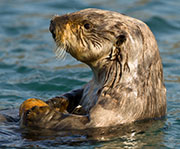
FRIDAY, April 11, 2014 (HealthDay News) — Sea otters off the Western coast of the United States were infected by the H1N1 swine flu virus that caused a human pandemic in 2009, new research shows.
During a 2011 project to monitor the health of northern sea otters off the coast of Washington state, researchers found evidence that many had been infected with the virus.
Seventy percent of the otters studied had antibodies for the 2009 H1N1 virus in their blood, which means they were previously exposed to the virus. None of the otters were sick when they were tested.
The precise date and source of exposure to the virus could not be pinpointed, the U.S. Geological Survey (USGS) and U.S. Centers for Disease Control and Prevention scientists said. They added that the findings indicate that human flu viruses can infect sea otters.
“Our study shows that sea otters may be a newly identified animal host of influenza viruses,” study-co-author and USGS scientist Hon Ip said in a government news release.
“We are unsure how these animals became infected,” lead author and CDC scientist Zhunan Li said in the news release. “This population of sea otters lives in a relatively remote environment and rarely comes into contact with humans.”
The study was published in the May issue of the journal Emerging Infectious Diseases.
Previous research showed that northern elephant seals off the central California coast were also infected with the 2009 H1N1 virus. Flu viruses have also been found in ducks, chickens, pigs, whales and horses, the researchers added.
“Our new study identifies sea otters as another marine mammal species that is susceptible to influenza viruses, and highlights the complex interspecies transmission of flu viruses in the marine environment,” USGS scientist LeAnn White said in the news release.
More information
The U.S. National Institutes of Health has more about the H1N1 virus.
Copyright © 2025 HealthDay. All rights reserved.

